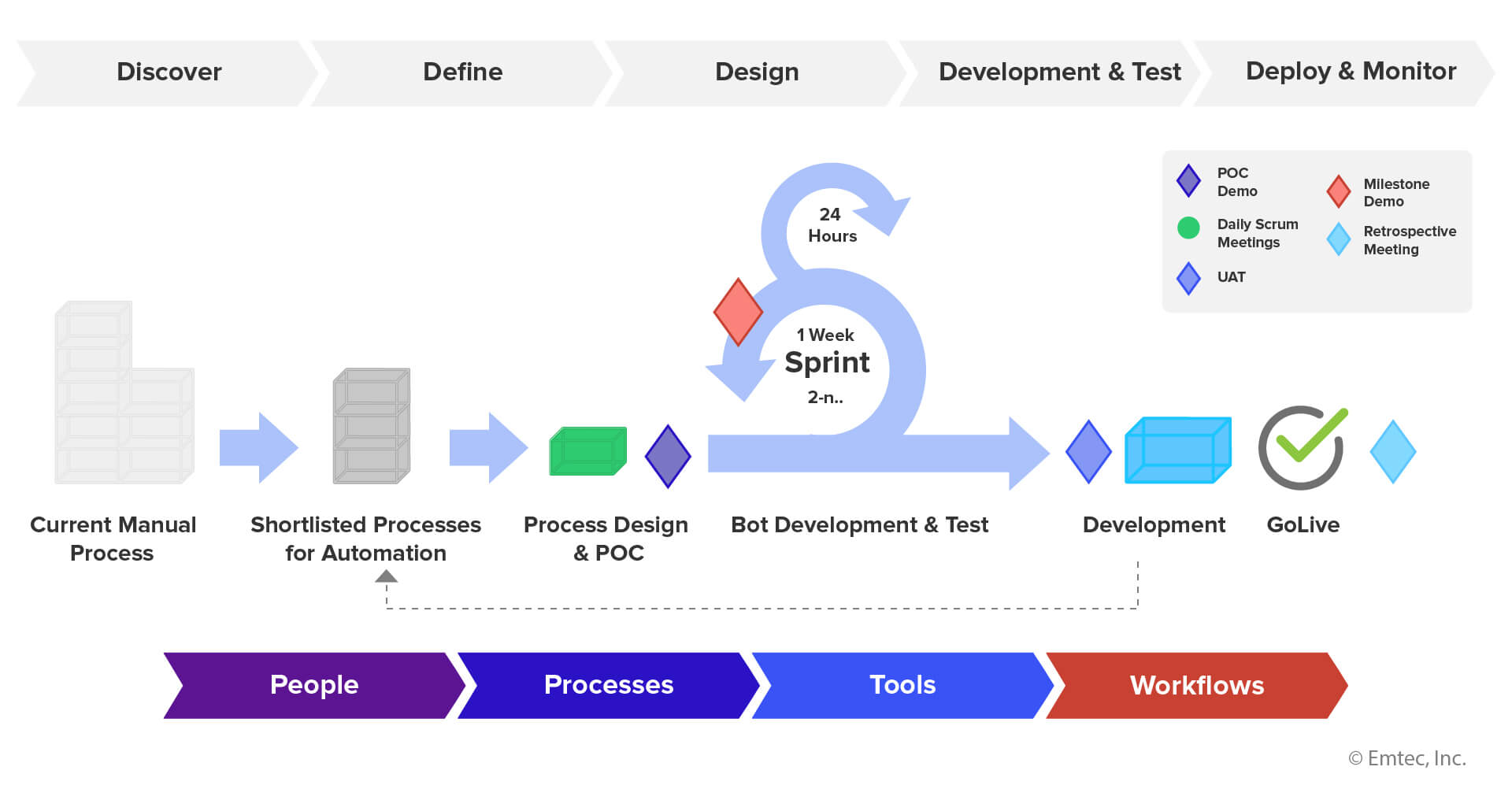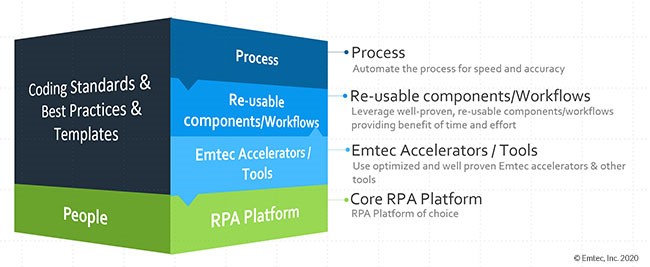07.22.20 By Sreenivas Vemulapalli

Robotic process automation (RPA) has become a go-to-solution for organizations who want to improve internal efficiencies and reduce costs. It has become a powerful toolset in digital transformation initiatives. Recent statistics suggest that over 24% of large and 9% of small and medium businesses have already started their RPA adoption journey. This trend makes RPA one of the fastest-growing global enterprise software segments with over 50% y-o-y growth.
Well, no surprises there! RPA offers a unique ability to integrate the latest SaaS solutions with legacy systems for multiple automation avenues, which enables organizations to derive additional and longer value from past technology investments. Automation is highly recommended for repetitive and manual tasks such as employee onboarding, payroll processing, SLA reporting, password management, service requests logging, scheduled maintenance and other similar back-office functions. It automates these mundane tasks for powerful efficiencies, with less human error and provides teams more time for strategic tasks.
As organizations pilot small RPA endeavors, their appetite grows to scale up RPA initiatives to improve and streamline more processes, workflows and application integrations throughout the organization. As per Deloitte, 78% of organizations that have implemented RPA are expecting to significantly increase their investment in next 3 years. However, only 3% of these have been able to scale RPA beyond the initial pilot. Their biggest challenge- how to scale up. The challenge is standardization of the RPA implementation process. This is where a Software Factory Model makes a big impact.
Software Factory is a set of resources designed to help developers quickly and consistently build applications using well-known architecture and design patterns. In RPA parlance, a process is identified based on the cost and benefit analysis and is then passed onto the software factory for automation.
By incorporating standardized processes, best practices and libraries to optimize RPA development, this methodology ensures a consistent and wider implementation of RPA with higher quality, reduced effort, lower costs with a quicker time to production.
While developing any software, businesses have an option go to for a “big bang” launch by utilizing a traditional waterfall approach where all software features are bundled and released together. Many adopt an iterative process commonly termed as the Agile Software Development Methodology wherein smaller software updates and features are released within a short time span. This agile approach enables continuous feedback from stakeholders to accommodate changes during development, resulting in higher quality software.
Cross-functional teams work together in an iterative fashion analyzing each release for quality, development time and costs. With Agile, project teams are better able respond to changing market needs quickly by tweaking feature definitions, development plans and expected deliverables during the project. Software development truly becomes “agile” and addresses ever-evolving customer demands.
At Bridgenext (former Emtec Digital), we have adopted a unique approach by combining the flexibility of the Agile Methodology with the concept of a “Software Factory Model” to accelerate bot development and keep costs under control. We believe, process automation should not be limited to being “robotic”, instead it should also be “intelligent” as in Intelligent Process Automation (IPA).
Our Agile Software Factory approach takes advantage of a collection of reusable components, workflows, standards & guidelines, accelerators, tools and reference implementations for common types of RPA bots to deliver process automation bots faster with a higher quality. This optimization reduces the time to deliver bots to 4-6 weeks without compromising on consistency, quality and meeting business objectives.

How RPA Solutions are developed in Sprints at Bridgenext
Bridgenext’s Agile Software Factory approach has 5 phases or as we call it – the “5 Ds”.
To initiate the automation process, we collaborate with our clients to “discover” and analyze the current manual processes and perform a cost & benefits analysis. Once the processes are shortlisted, we “define” the process design documents and “design” a Proof of Concept (PoC) demo. This demo is the first major milestone of the RPA development project.
In the fourth step, “development and test”, we initiate an iterative development process. In sprints of one week, the PoC (pilot bot) is developed and tested. Daily scrum meetings help keep track of progress and provide opportunities to make necessary tweaks. Several reusable components, workflows and processes, as depicted in the graphic below, are used during the development processes to reduce time to launch. Development is also driven by highly evolved coding standards, best practices and templates to improve code quality and reduce bugs.

Bridgenext IPA Factory Model
At the end of each sprint, a working demo of the automated process is presented for feedback and adjustments that may be required in future sprints. Once the PoC is ready for deployment, User Acceptance Testing (UAT) is conducted to educate end users on the new process and how to utilize the automation once deployed. The RPA solution is then “deployed” in production and a retrospective discussion is held to identify any areas for improvement in future process automation initiatives.
The Agile methodology in RPA development presents clients with multiple benefits:
Getting started with RPA isn’t a herculean task if you take a systematic approach by incorporating an Agile RPA Software Factory. The Bridgenext team has extensive experience delivering process automation bots for a wide range of industries. If you need help scaling your RPA efforts, reach out to us at digital@bridgenext.com to discuss your RPA roadmap.